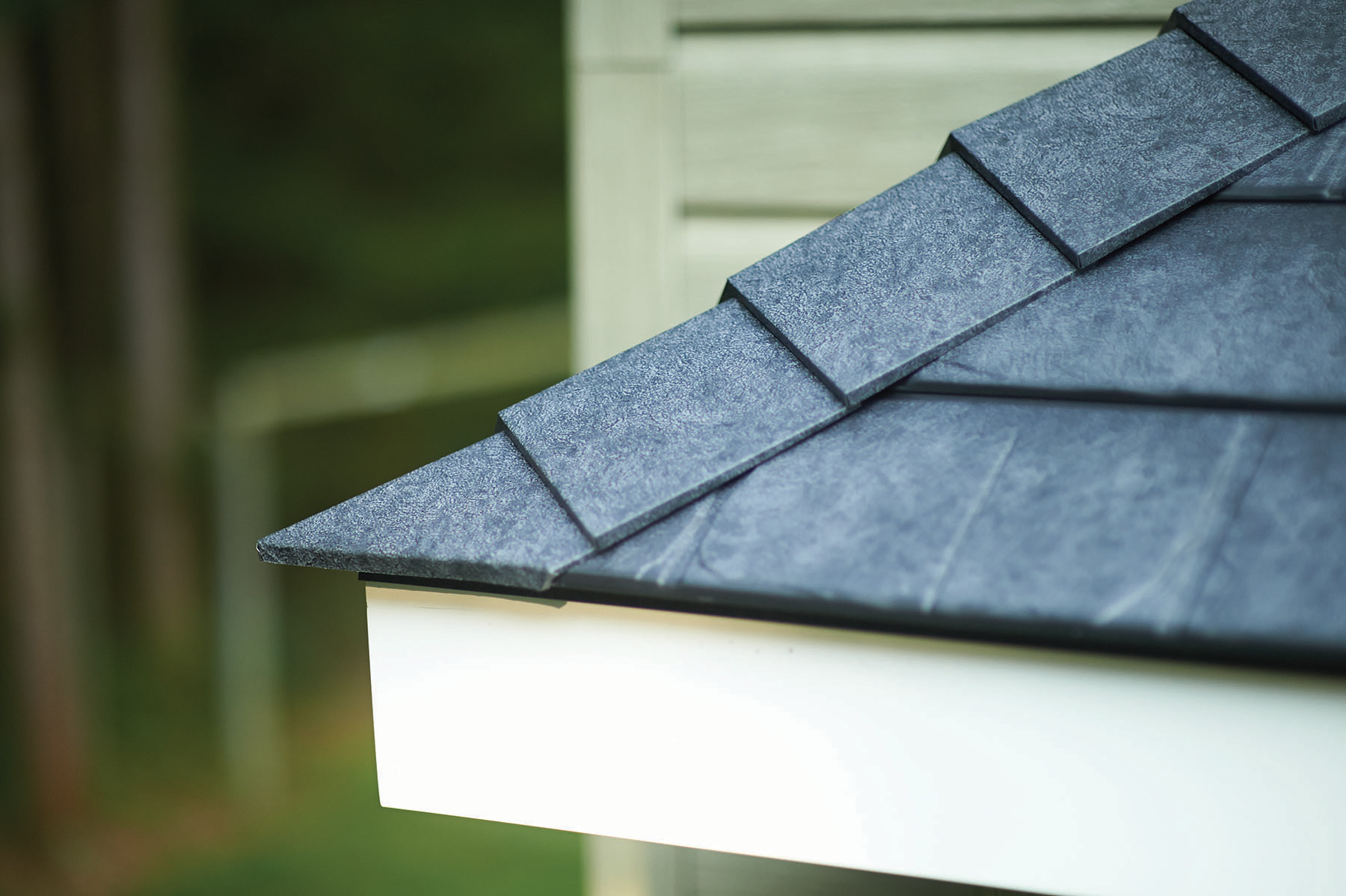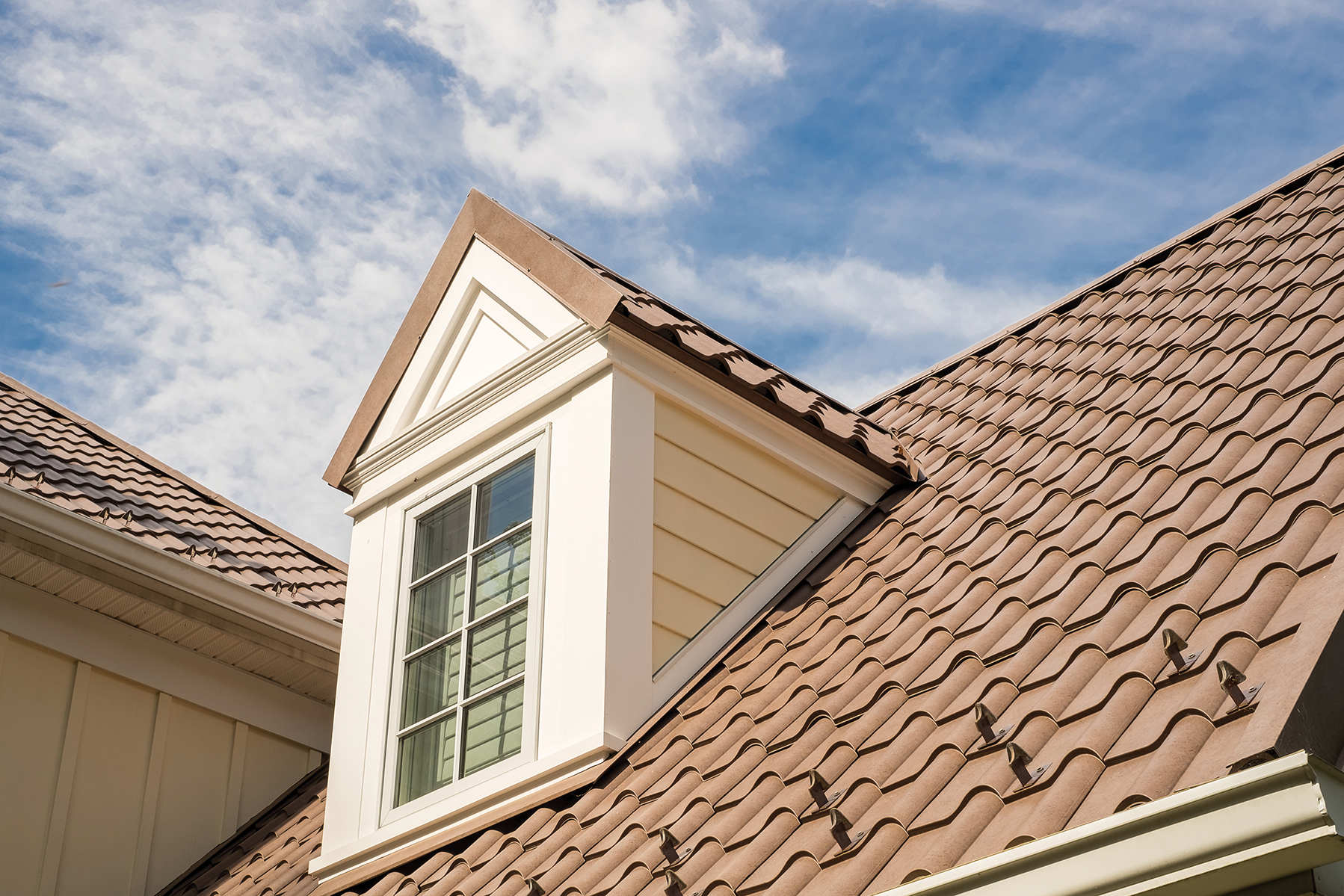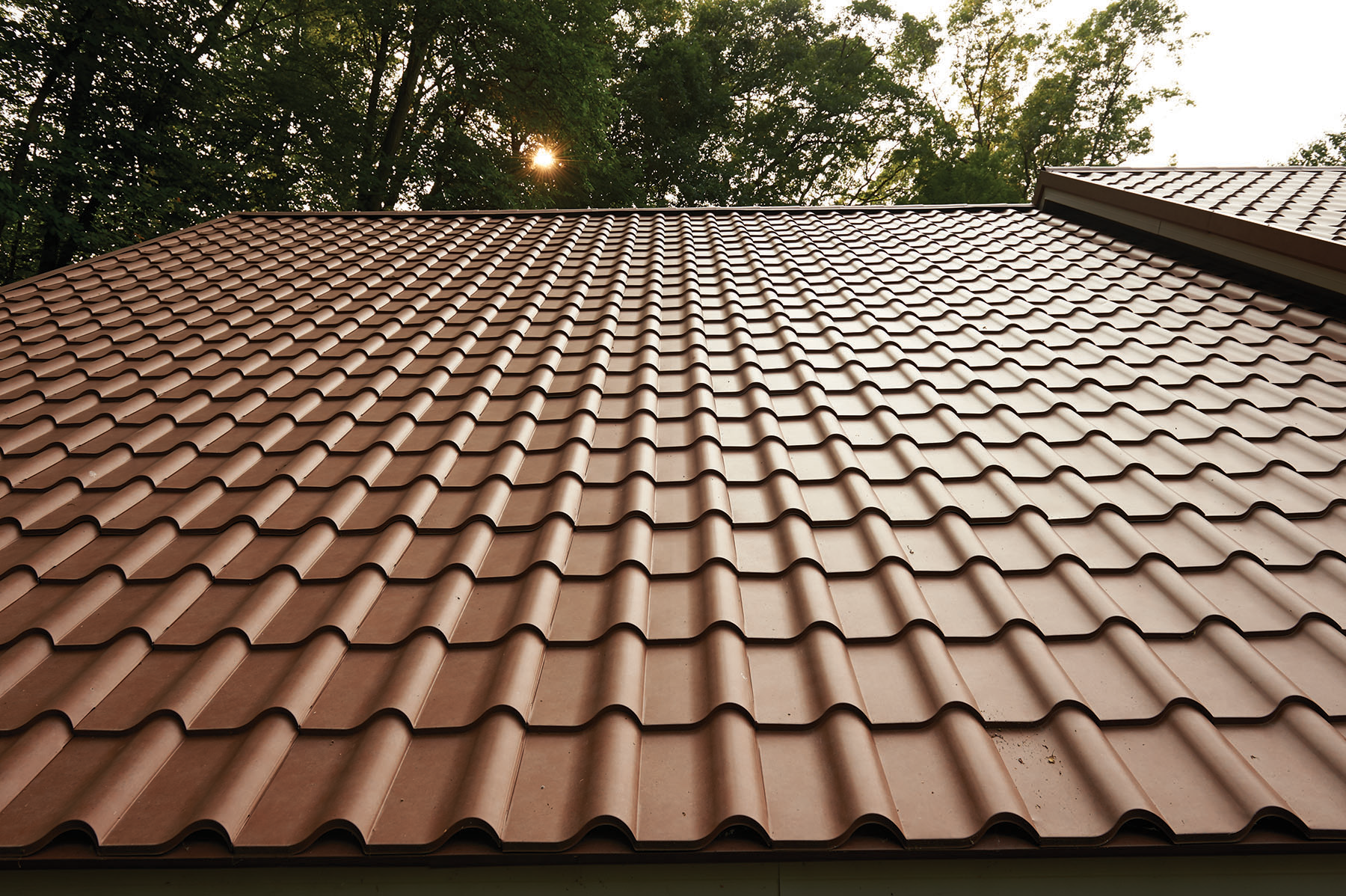There are a lot of misunderstandings about metal roofing. The most enduring myths say metal roofing is noisy, only found on barns, is susceptible to rust and attracts lightning. However, the older tin roofs many people think of when they think of metal roofing mostly have been phased out to make way for newer metal roof system types that incorporate galvanized steel, copper, aluminum or zinc and can be produced to mimic traditional roofing materials.
The versatility of stamped panel metal roofing is making it a popular material for residential and light commercial construction. According to a 2019 report from The Freedonia® Group, metal roofing sales are set to outpace overall roofing growth through 2023.
As homeowners look for ways to cut energy bills in the wake of COVID-19 shelter-in-place restrictions and others are faced with stronger and more frequent storms, stamped panel metal roofing may be the right option for your residential customers.
The pros and cons
Standing-seam metal roofing has been around for decades and still is used in new and retrofit construction. It consists of vertical panels and is limited to certain architectural styles. Stamped panel metal roofing is metal cut into panels that look, feel and function like other roof systems. It is installed similarly to modern roof systems and includes an underlayment to prevent noise associated with older metal roof systems.
There are some prevailing misconceptions about stamped panel metal roofing such as it’s more difficult to install than traditional roof systems and may not be worth the higher upfront costs that limit its full adoption by some roofing contractors. Understanding how stamped panel metal roofing is installed and functions will help you be confident about a product that is steadily assuming a bigger role in the roofing industry.

Stamped panel metal roofing can be shaped to resemble natural products such as shake, slate and tile.
Stamped panel metal roofing has superior impact, fire and wind resistance compared with most asphalt and wood shake roofing products. Unlike other roofing materials that may need to be replaced every 20 to 30 years, metal roofing can have a life expectancy of 50 years or longer.
Stamped panel metal roofing is versatile and can be shaped to resemble natural roofing products such as shake, slate and tile without the heavier weight and maintenance associated with those materials. Metal roofing is algae-resistant, generally 100% recyclable and comes with the option of cool roof (solar-reflective) paint coatings that may lower rooftop temperatures, contributing to energy savings throughout the life of the product.
However, there are a few tradeoffs to consider. Compared with asphalt roofing, stamped panel metal roofing typically requires more of an upfront investment. Additionally, certain types of metal roofing don’t perform well in coastal areas because of salty sea air; galvanized (zinc-coated) steel, zinc, aluminum or copper roofing products may be optimal in those areas.
The most popular type of stamped panel metal roofing is made of galvanized steel, which is coated by stone or a PVDF (polyvinylidene fluoride) paint system. In addition to heat-reflecting colors, PVDF paints have ultraviolet stability as well as chemical, scratch and flame resistance. When metal panels are installed on a clean roof deck, stamped panel metal roofing with PVDF paints will resist rust and maintain their true colors for many years. A variety of color options also means architects and builders can choose bold colors or opt for more traditional earth tones without sacrificing performance.
Water management
When properly installed, stamped panel metal roofing is an effective choice for protecting homes from water intrusion. However, like anything made of metal, it expands and contracts in heat. Different metals also can interact in negative ways, which can cause corrosion and rust if they contact one another, especially when moisture is present.
Preventing water intrusion in stamped panel metal roofing requires additional expertise, but a few precautions will ensure the metal roof system you’re installing performs to expectations. The foundation for any water-resistant, steep-slope roof system is proper underlayment. Although many stamped panel metal roofs have solar-reflecting properties, the undersides of metal panels often absorb a great deal of heat (up to 250 F). A synthetic underlayment designed especially for use beneath metal roofing materials is the best option to resist heat destruction that can expose roof decks to moisture.
Unlike porous felt underlayments of the past, a good synthetic underlayment prevents water from wicking through to the deck. Using a high-temperature waterproofing underlayment at the eaves and around roof penetrations will help maintain a watertight barrier under the panels as it is designed to seal around nails driven through it. The waterproofing underlayment also will help defend against ice dams and potential roof system damage caused by freeze-thaw cycles.
Although underlayments, flashings and other waterproofing methods provide excellent moisture defense, roof system design also plays a role. Homes with a lot of architectural elements (gables, hips, valleys) can make a roof susceptible to water intrusion. Any point where the roof line stops and starts is an invitation for moisture, so it is best to use a good quality waterproofing underlayment under all unique structural elements where there is a high potential for leaks.
Another moisture-prevention detail is fasteners. Unlike asphalt roof systems that typically are nailed down, most stamped panel metal roof systems require screwed fasteners to attach the panels to the deck. Underdriven, loose or off-center fasteners can turn a well-functioning metal roof system into a metal strainer, eventually leading to roof system failure.
Take the time to make sure every fastener is driven straight and flush to the panel. Dividing labor so one installer can focus solely on driving fasteners is one way to limit the risk of installation errors. Also, look for stamped panel metal roofing products with hidden or covered fasteners, which can greatly limit the ability of water to pass through fastener locations.
Corrosion and condensation
Most stamped panel metal roof systems on the market are stone-coated or protected by corrosion-resistant paint systems. However, saltwater mist can negatively affect metal over time. For this reason, many metal roof system warranties are voided or limited when the product is installed too close to a body of saltwater. Consult with the manufacturer before selling or installing metal in coastal and seaside communities.
Corrosion can occur if the undersides of metal panels are not properly coated or become damaged. A granulated underlayment installed directly under metal panels can scratch the layer of protective paint, exposing the metal to oxidization. A proper synthetic underlayment will prevent oxidization.
Fasteners, rivets, flashing, trim, gutters and nongalvanized metals can interact poorly when in contact with weak or damaged metal panels. To prevent the interaction of metals, extend the lifespan of the roof system and ensure the best warranty protection, it is best to rely on a single manufacturer for all roof system components.
Condensation under metal panels is a possibility in any climate but especially in humid or swampy climates such as the Southeast. Proper ventilation of attic spaces is extremely important for preventing the buildup of moisture that can lead to condensation. Venting a roof from the soffit to ridge is the optimal way of preventing condensation under metal and eliminates the potential for various moisture issues.
Installation
Although installing a stamped panel metal roof system is similar to installing an asphalt shingle roof system in many ways, several steps are necessary to ensure a finished product looks good and performs well. Following are several things you should pay close attention to when installing prefabricated stamped panels.
Acquire proper tools
Metal cutting (aviation) snips, which retail for about $15, replace the utility knife you would use to cut asphalt shingles and are the primary tool used to separate metal panels and cut them to desired lengths. A good impact driver ($100-$300) uses rotation and concussive force to drive fasteners through the thickest, densest materials. You’ll need the extra torque to secure metal panels to roof sheathing.
A hand seamer ($30-$60) will help you make accurate, clean angle bends in sheet metal, which is crucial around hips and ridges to make sure the individual metal panels are flush with one another. Other tools are optional, but having these basics will make the job go a lot quicker and with less risk of costly errors.
Install on a clean deck
CertainTeed LLC, Malvern, Pa., recommends tearing off all existing roof systems before installing a new stamped panel metal roof system. If the previous roof system was asphalt, it is likely any existing shingles or starter shingles will create a telegraphing effect in which granules, roofing nails and other debris punch through the undersides of the metal panels, creating dents and other imperfections that can’t be fixed. Also, granules in asphalt can scratch through protective paint or galvanized layers if they contact the undersides of metal panels, causing rust and potential roof damage. A roof deck should be an even plane of 15/32- to 1/2-inch-thick plywood, 7/16-inch-thick nonveneer panels or nominal 1-inch-thick wood. Be sure to inspect the roof deck for debris and metal shavings before and after installation.
Use the right underlayment

Stamped panel metal roofing is cut into panels that look, feel and function like other roof systems.
Many stamped panel metal roofing products have cool roof paint options to keep the temperature inside a home cool. However, the immediate undersides of metal panels can get extremely hot—beyond the melting point of many asphalt-based sheet membranes. For this reason, a high-quality, high-temperature synthetic underlayment is recommended to avoid heat-related damage to the waterproofing underlayment and extend the life of the roof system. The roof system manufacturer likely will recommend a suitable underlayment, but a self-adhering synthetic membrane also will serve as an effective vapor retarder and provide excellent ice dam protection especially around eaves, valleys, dormers and rising walls because it is fully adhered to the substrate.
Handle panels with care
Stamped panel metal roof systems are strong and lightweight, but individual metal panels can be fragile or challenging to handle.
Although handling practices differ among products, nonstructural panels tend to be more fragile because of their smaller rib dimensions. Structural panels also are fragile until installed and interlocked with the rest of the roof system. In general, panels should be carried standing on their edges rather than lying flat to avoid bending and warping. Longer panels should be carried with multiple points of support and be laid in place using as many people as necessary working in unison.
Cut top to bottom

Stamped panel metal roofing is available in a variety of colors.
When cutting panels to length, begin cutting from the top of the panel and then downward toward the preformed bend at the bottom. This ensures the cleanest shear and keeps the rolled edge intact for optimal locking to other panels. In general, install panels starting from the bottom and then right to left, beginning with the bottom right corner of the roof deck. This will help minimize foot traffic on installed panels and avoid unnecessary dings and damage.
If the panels are an interlocking system, use the heel of your hand to ensure each panel is fully engaged to the panel below it before fastening it to the deck. Wear clean, soft-sole, nonmarking shoes when walking on installed panels and only step on areas that have full contact to the roof deck.
Install fasteners properly
Underdriven fasteners allow water and moisture to enter a roof assembly through unsealed holes. Overdriven fasteners create depressions around the areas in which they are installed, allowing water, condensation and moisture to pool. This can lead to premature corrosion and a marred roof surface, especially over reflective coatings and finishes or when using exposed, through-panel fasteners. Make sure tools are set up properly by using an off-roof test panel or scrap metal. If using pneumatic tools, make sure the tool is set to the correct air pressure. Significant pressure is lost when long air lines, kinked hoses or leaky couplers are used. Discourage roofing workers from borrowing tools as they may have different settings; be sure to provide your own.
Stand out
Although stamped panel metal roof systems have similarities, always install products according to manufacturers’ recommendations to ensure the best appearance. If you’re just getting into metal roofing with a particular product or your team is unsure about any aspect of an installation, contact the manufacturer who can connect you with a local product manager; often, they will be glad to send someone to your job site to conduct training and even get on the roof with you to ensure a quality installation.
When installed properly with some precautions and preparations, your stamped panel metal roofing project will stand out among neighboring structures for years to come.
Dale Walton is manager, residential product marketing, at CertainTeed LLC, Malvern, Pa.
For an article related to this topic, see “Beyond the norm.”


